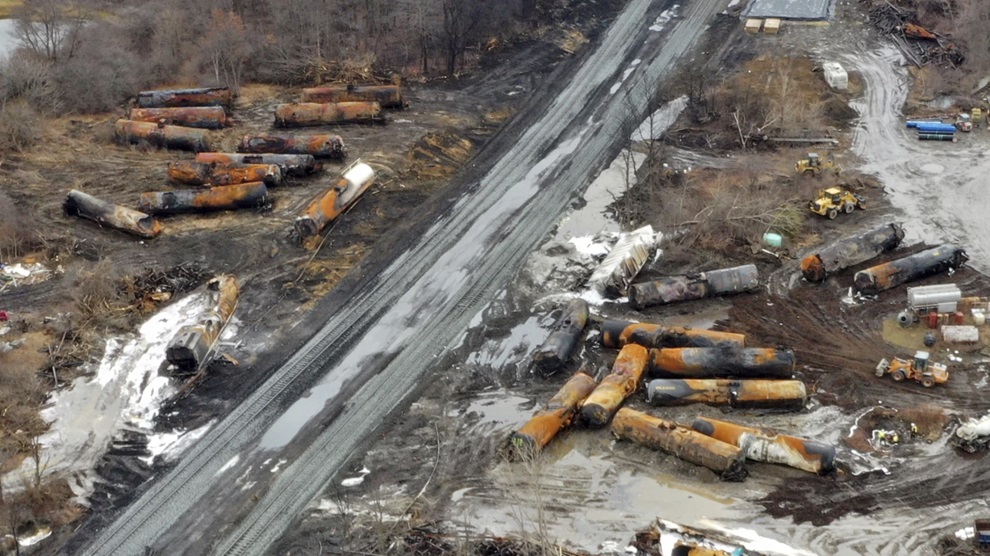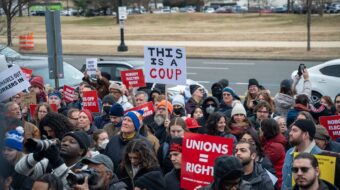Union leaders to try again on rail safety; Corporate greed sidetracked it (original) (raw)

This image taken with a drone shows the continuing cleanup of portions of a Norfolk Southern freight train on Feb. 9, 2023, that derailed in East Palestine, Ohio. | Gene J. Puskar/AP
WASHINGTON—Corporate greed by the railroad lobby sidetracked an important rail safety bill in the last Congress that would have forced all freight railroads to put safety and people over profits, rail union leaders say. So now they and three lawmakers are trying again, hoping for a helper in the vice presidential chair.
But whether J.D. Vance, then an Ohio Republican senator and a co-sponsor of the safety bill that died, will really help is an open question. He’s part of the Republican Trump administration that is hell-bent on smashing federal rules and turning business free—free to prey on the rest of us.
For the nation’s six big Class I freight railroads, that means leaving them free to keep cutting costs by cutting people, via so-called Precision Scheduled Railroading, cutting corners on inspections, pressuring workers to cover up safety problems and shoveling cash in dividends, stock and pay–$146 billion total in the last decade–to their Wall Street capitalist backers.
The object of the lawmakers and the eight rail union leaders: To resurrect that rail safety legislation and either get it through Congress as two stand-alone laws or wrapped into a giant federal transportation programs reauthorization bill. The two measures were introduced on February 4.
“What’s happening in the railroad industry is not OK,” said Smart-TD’s Jared Cassidy. The workers “still face challenges, headwinds, obstacles and problems” in making sure trains run safely, added Cassidy, the union’s alternate legislative director.
“You have a railroad lobby that does everything possible to prevent safety costs. They’re focused on profit, not on men and women” who work on the railroads—or live near them.
“If you eliminate the precursors to the accidents” by forcing the railroads to put safety before shareholders “you eliminate the accidents,” explains Mike Baldwin, president of the Railroad Signalmen, one of several rail union leaders at the February 3 zoom press conference.
The lead sponsor of one safety bill, Rep. Dana Titus, D-Nev., has spoken to her Transportation Committee’s Republican chair about hearings and pushing the issue, but got no commitment. In the prior Congress, railroad lobbying and campaign cash derailed the safety bill.
Titus knows all about the hazards: A Union Pacific mainline runs right through downtown Las Vegas, and her district includes most of Nevada’s dominant city.
Titus and Cassidy joined AFL-CIO Transportation Trades Department President Greg Regan, who organized the session, along with co-sponsoring Reps. Emilia Sykes, D-Ohio, and Chris Deluzio, D-Pa. Rep. Troy Nehls, R-Texas, sent a short video.
All but Nehls discussed the massive Norfolk Southern derailment and venting of toxic chemicals into the. air and water precisely two years before, on Feb. 3, 2023, in East Palestine, Ohio. “The people of eastern Ohio have suffered so much from corporate greed,” Sykes said.
“Our greatest fear is a train derailment can become a mass casualty event. But we have yet to see meaningful reform out of Congress” to force railroads to put safety and people over profits, said Regan.
Each railroader—Smart-TD’s Cassidy, Signalmen’s President Baldwin, Maintenance of the Way Employes/Teamsters President Tony Cardwell, Locomotive Engineers and Trainmen/Teamsters VP Vince Verna, Train Dispatchers official Brandon Denucci, Machinists Lodge 19 President Reece Murtagh, Boilermakers Railroad Lodge Director John Mansker, and Transportation Communications Union Legislative Director Dave Arouca—took turns echoing Regan and the legislators.
Each brought the safety perspective of his craft, painting an overall picture that the nation’s big Class I railroads aren’t just an accident waiting to happen. They’re already happening: “Three derailments a day, Cardwell said. “And it”—that problem—“is getting worse, not better.”
“But they don’t get attention, because they’re in the countryside, not in the cities,” he added.
For Norfolk Southern, whose train derailed in East Palestine, and the five other big freight Class I railroads, profits headed for Wall Street investors and corporate honchos’ pockets come first, the railroaders and the lawmakers stated.
The big freights won’t even implement a measure they agreed to in the immediate aftermath of the East Palestine crash: A voluntary “Confidential Close Call Reporting System” for railroaders to anonymously report safety hazards on freight trains to the Federal Railroad Administration before the hazards turn into derailments and crashes.
And when rail workers speak up about hazards, they’re intimidated and fired. But Cardwell noted the last three BMWE workers canned for whistleblowing sued. Not only did they win, but the evidence in court exposed the big freight railroads’ laxity.
“A lot of our derailments are track-caused,” since many rail tracks around the U.S. are old, Cardwell added. The big freight carriers don’t send his members out often enough to maintain them.
Instead, the big freight railroads “lengthened the trains and treated communities like ‘collateral damage’ in their pursuit of profits,” said Rep. Deluzio, whose Beaver County, Pa., constituents were in the East Palestine evacuation zone.
“One thing we know about these types of incidents is they’re 100% predictable and 100% preventable,” added Rep. Sykes. Jennifer Homendy, chair of the independent National Transportation Safety Board (NTSB), which probes such industrial accidents, said the same thing both days after East Palestine and in the agency’s final report on the disaster, 18 months later.
That crash derailed one-third of the one-and-a-half-plus miles long freight train. Officials, acting on inadequate data, thought venting tank cars filled with dangerous chemicals would avoid a massive explosion. NTSB said venting was unnecessary. It also turned East Palestine into a disaster.
Chemical gases formed a mushroom cloud over the town, thousands of people in and around it and nearby Pennsylvania were evacuated. Chemical runoffs poisoned wells and streams as far away as the suburbs of Canton, Ohio, the southern end of Sykes’s district. Chemical seepage into groundwater and streams killed thousands of fish, plus pets.
NTSB, an independent investigative agency, said a massively overheated wheel bearing on one freight car broke, in turn breaking an axle and sending that car and dozens of others off the tracks.
There weren’t enough sensors on the Norfolk Southern tracks to catch the heating before it was too late. And the warning first went to an NS track supervisor hundreds of miles away, on his computer. He relayed it to the train crew.
No one was dead or injured, but the veteran railroaders called that a matter of luck. Regan reminded the listeners about the prior such huge derailment and crash, a decade ago in Lac Megantic, Quebec. That train exploded in a fireball, destroying an entire downtown and killing 47 people.
Besides the rail lobby’s opposition, the Republican platform, also known as Project 2025, and crafted by the radical right Heritage Foundation, stands in the way of rail safety. Buried in its depths are measures that go in the exact opposite direction from what Regan and the railroaders advocate.
One big measure the unions have pushed for years—and did so again at the press conference–is mandated two-person crews on all freight trains. One reason the NS East Palestine crash wasn’t fatal was it had a two-person crew, plus a trainee. The Lac-Megantic train had only an engineer.
The Biden administration proposed mandating two-person crews. Key rail states through which most of the nation’s freight traffic flows—New York, Nevada and especially Illinois—have written two-person crews into law. Nevada is the gateway state to California. That rule is pending, Regan said.
The Biden mandate two-person “crew size is not based on safety considerations,” Project 2025 retorts. “It is designed to reduce flexibility by making it impossible for railroads to operate with crews of fewer than two in circumstances where there is no operational need for the second crew member.” Project 2025 produced no data to prove its assertion. One railroader said having a second crewmember on a freight reduces accidents by 28%.
And while the union leaders pushed at their press conference for more, more thorough and more frequent inspections, Project 2025 advocates “a modern inspection program that takes advantage of technological ways to inspect track. It is refusing to amend 50-year-old track inspection requirements, leaving customers with higher costs.”
The platform also wants brake inspections “done electronically” to “enable extending the interval between brake inspections for trains.” In plain English, fewer humans eyeballing trains less often.
Baldwin, the Railroad Signalmen president, brought up another problem: At-grade rail-road crossings. Miles-long freight trains block grade crossings for hours. A federal program, part of the infrastructure law in the prior Congress, to pay to replace all remaining grade crossings with bridges and tunnels.
Many current hazardous crossings “are in blind spots and don’t have flashing lights and gates,” said Baldwin. Truckers and farm tractor drivers try to outrun a train, and get stuck on the tracks. There is—or was—federal funding to build overpasses and end such hazards, including $27 million just sent to Will County, Ill., to end a dangerous crossing down the street from a high school in New Lenox, Ill.,
GOP President Donald Trump’s federal grant spending freeze, at the behest of multibillionaire Elon Musk, may have stopped that project, and all the others.
Project 2025 also says there aren’t “any safety benefits” from federal certification of train dispatchers, who control movement of trains—electronically and by radio—in yards and on tracks. The legislation mandates that, too. Train Dispatchers Vice President Brandon DeNucci retorts federal standards and certification are needed. Otherwise, the freight railroads can “certify” untrained people.
“Train dispatchers are the [railroad] equivalent of air traffic controllers. They’re the first line of defense” against crashes, in particular between trains, he explained.
We hope you appreciated this article. At People’s World, we believe news and information should be free and accessible to all, but we need your help. Our journalism is free of corporate influence and paywalls because we are totally reader-supported. Only you, our readers and supporters, make this possible. If you enjoy reading People’s World and the stories we bring you, please support our work by donating or becoming a monthly sustainer today. Thank you!



